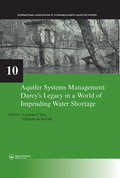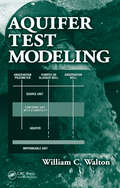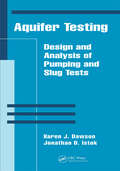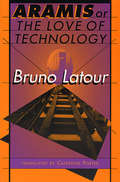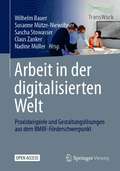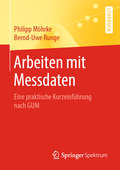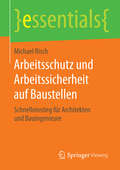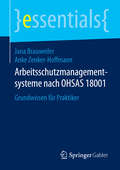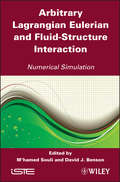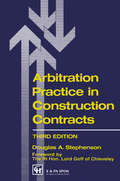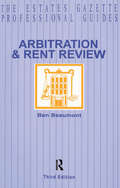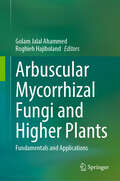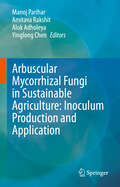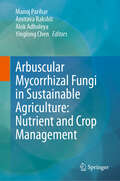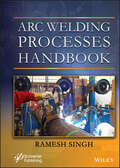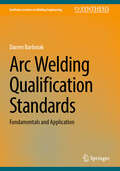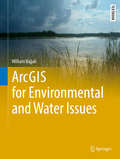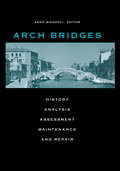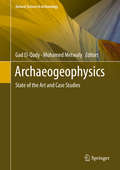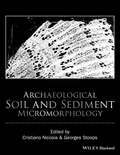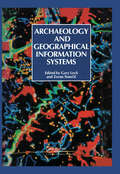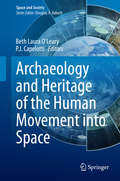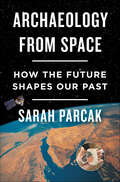- Table View
- List View
Aquifer Systems Management: Selected Papers on Hydrogeology 10 (IAH - Selected Papers on Hydrogeology)
by Laurence Chery Ghislain De MarsilyPresented at the International Association of Hydrogeologists Dijon Symposium, this book contains 43 selected papers, grouped into six topics, that address the following issues: large aquifers, resource assessment; large aquifers, water salinity and evolution; karstic and carbonate aquifer systems; geothermal aquifer systems; aquifer contamination studies; and aquifer monitoring systems and management. In celebration of the 150th anniversary of the publication of Darcy's Law, the volume includes a summary of Darcy's life and his contribution to science, and five invited contributions on modern methods to estimate the hydraulic conductivity of aquifers.
Aquifer Test Modeling
by William C. WaltonIn recognition of the trend toward using numerical methdos for analyzing aquifer test data, Aquifer Test Modeling delineates the application of numerical Laplace inversion analytical equations and numerical models and demonstrates the use of public domain software. Written by a leading expert with over fifty years of experience, this highly practic
Aquifer Testing: Design and Analysis of Pumping and Slug Tests
by Jonathan D. Istok Karen J. DawsonNew! A practical, easy-to-use reference for the design and analysis of groundwater pumping and slug testsAquifer Testing: Design and Analysis of Pumping and Slug Tests is a complete design and analysis reference emphasizing practical solutions for engineers, scientists, consultants, and students knowledgeable in basic ground water theory. T
Aramis, or the Love of Technology
by Bruno LatourBruno Latour has written a unique and wonderful tale of a technological dream gone wrong. As the young engineer and professor follow Aramis' trail--conducting interviews, analyzing documents, assessing the evidence--perspectives keep shifting: the truth is revealed as multilayered, unascertainable, comprising an array of possibilities worthy of Rashomon. The reader is eventually led to see the project from the point of view of Aramis, and along the way gains insight into the relationship between human beings and their technological creations. This charming and profound book, part novel and part sociological study, is Latour at his thought-provoking best.
Arbeit in der digitalisierten Welt: Praxisbeispiele und Gestaltungslösungen aus dem BMBF-Förderschwerpunkt
by Susanne Mütze-Niewöhner Sascha Stowasser Wilhelm Bauer Claus Zanker Nadine MüllerDas vorliegende Open-Access-Buch umfasst Beiträge aus 29 Verbundvorhaben sowie dem begleitenden Verbundprojekt „TransWork“. Im Rahmen des Förderschwerpunkts „Arbeit in der digitalisierten Welt“ des Bundesministeriums für Bildung und Forschung wurden in den Projekten Entwicklungen im Transformationsprozess der Arbeitswelt analysiert, Lösungsansätze entwickelt und diese wissenschaftlich begleitet. In den Beiträgen werden Einblicke in die erarbeiteten Erkenntnisse und entwickelten Konzepte der Projekte gegeben. Hieraus lassen sich für Akteure aus Politik und Wirtschaft Handlungsempfehlungen ableiten und es ergeben sich neue Forschungsimpulse für die Wissenschaft.
Arbeiten mit Messdaten: Eine praktische Kurzeinführung nach GUM
by Philipp Möhrke Bernd-Uwe RungeDas vorliegende Lehrbuch bietet Studierenden der Natur- und Ingenieurswissenschaften einen übersichtlichen und anschaulichen Einstieg in den Umgang mit Messdaten und deren Interpretation unter Verwendung der Messunsicherheit – früher oft Fehlerrechnung genannt. Dabei stehen das Verständnis und die Vermittlung von direkt anwendbarem Wissen im Vordergrund. Auf lange mathematische Herleitungen wird weitgehend verzichtet.Auf Basis einiger einfacher Grundprinzipien wie der Verteilung der Messwerte oder dem mathematischen Modell einer Messung führt dieses Buch in zentrale Themen ein:- das Messen an sich,- die Angabe von Messergebnissen,- das Konzept der Unsicherheit,- die Auswertung von Messdaten mittels verschiedener Methoden,- sowie die Bewertung der erhaltenen Ergebnisse.Alle diese Themen werden anhand vielfältiger Beispiele ausführlich dargestellt und die Anwendung der abstrakten Konzepte anhand konkreter Zahlenbeispiele veranschaulicht. Fragen zur Selbstkontrolle sowie zur Vertiefung der Inhalte runden jedes Kapitel ab.
Arbeitsschutz und Arbeitssicherheit auf Baustellen: Schnelleinstieg für Architekten und Bauingenieure (essentials)
by Michael RischMichael Risch beschreibt, wie man Baustellen sicherergestaltet, die eigene Verantwortung erkennt und damit das Unfall- undHaftungsrisiko reduziert. Ausgehend von den realen Erfordernissen an dieArbeitssicherheit unterstützt der Autor so bei der Einordnung, Wertung undAnwendung von Vorschriften und Regeln zur Unfallvermeidung und zumArbeitsschutz auf Baustellen. Auf dieser Grundlage wird der Leser befähigt,diese auf den jeweiligen Sachverhalt in der Praxis zu übertragen und sinnvolldanach zu handeln. Die Planung komplexer Gebäuden sollte mit einer möglichstgenauen Kenntnis der tatsächlichen Bauabläufe Hand in Hand gehen, denn nur sokann bereits im Planungsprozess eine vorausschauende Gefährdungsbeurteilung fürdie Bauausführung erfolgen. Mit der Inbetriebnahme und Nutzung eines Gebäudes mussauch dessen Wartung, Pflege und Instandhaltung sicher und ungefährdet durchführbarsein, was im Planungsprozess zu berücksichtigen und in der Bauausführungumzusetzen ist.
Arbeitsschutzmanagementsysteme nach OHSAS 18001: Grundwissen für Praktiker (essentials)
by Jana Brauweiler Anke Zenker-HoffmannJana Brauweiler und Anke Zenker-Hoffmann stellen in diesem Essential Anforderungen an Arbeitsschutzmanagementsysteme (AMS) nach der Occupational Health Safety Assessment Series 18001 (OHSAS 18001) vor. Die Autorinnen definieren Begriffe und systematisieren die vorhandenen Konzepte zur Einführung eines AMS nach Gestaltungsebenen. Da von den Konzepten die internationale Norm OHSAS 18001 in der internationalen Verbreitung eine führende Rolle einnimmt, erläutern sie an diesem Beispiel ausführlich die Anforderungen an ein AMS nach den Phasen des Managementkreislaufes plan-do-check-act und unterlegen diese, wo möglich, mit Beispielen.
Arbitrary Lagrangian Eulerian and Fluid-Structure Interaction: Numerical Simulation (Wiley-iste Ser.)
by David J. Benson M'Hamed SouliThis book provides the fundamental basics for solving fluid structure interaction problems, and describes different algorithms and numerical methods used to solve problems where fluid and structure can be weakly or strongly coupled. These approaches are illustrated with examples arising from industrial or academic applications. Each of these approaches has its own performance and limitations. Given the book’s comprehensive coverage, engineers, graduate students and researchers involved in the simulation of practical fluid structure interaction problems will find this book extremely useful.
Arbitrary Modeling of TSVs for 3D Integrated Circuits (Analog Circuits and Signal Processing)
by Khaled Salah Yehea Ismail Alaa El-RoubyThis book presents a wide-band and technology independent, SPICE-compatible RLC model for through-silicon vias (TSVs) in 3D integrated circuits. This model accounts for a variety of effects, including skin effect, depletion capacitance and nearby contact effects. Readers will benefit from in-depth coverage of concepts and technology such as 3D integration, Macro modeling, dimensional analysis and compact modeling, as well as closed form equations for the through silicon via parasitics. Concepts covered are demonstrated by using TSVs in applications such as a spiral inductor and inductive-based communication system and bandpass filtering.
Arbitration Practice in Construction Contracts
by D.A. StephensonConsiders each stage in the course of an arbitration in detail, from the claimant's decision to seek the means of resolving a dispute to the arbitrator's award, explaining clearly and concisely what is expected of the claimant, respondent and arbitrator and when.
Arbitration and Rent Review
by Ben BeaumontArbitration and Rent Review has become a standard work in the property world for guidance on rent review. In a clear style, the author examines the procedures that landlord and tenant should follow in order to agree a new rent or to have one decided by arbitration. By means of cases, he highlights the key areas of conflict that come before the courts, the contentious issues being introduced in the order in which they would be encountered by landlords or tenancts facing a review.
Arbuscular Mycorrhizal Fungi and Higher Plants: Fundamentals and Applications
by Golam Jalal Ahammed Roghieh HajibolandThis book covers the fundamentals of arbuscular mycorrhizal fungi (AMF) and higher plant symbiosis with potential implications in crop production. It provides new insights into our understanding of the mechanisms of AMF-mediated plant growth regulation and stress tolerance covering the most recent biochemical, physiological, molecular, environmental, and ecological studies. Focusing on AMF-induced physiological and molecular mechanisms of enhanced tolerance to stress, environmental stress is discussed in several dedicated chapters. The book provides not only updated information with new insights and perspectives but also several new topics, such as a comprehensive discussion on biotic stressors, AMF interaction with other microorganisms, non-host plant species, plant secondary metabolism, signaling events in plant-AMF symbiosis, AMF-mediated nutrient acquisition and subsequent stress tolerance. The book also discusses the potential implications of AMF for sustainable crop production in the context of climate change. The book can be a useful reference book for academics and scientists involved in related research, such as academics in agronomy and plant sciences, scientists involved in beneficial fungi research, chemists, industrialists, and employees involved in the production and marketing of biofertilizers, master and doctoral degree students of agronomy, horticulture, and plant protection, consultants working on the production of crops in marginal environments as well as environmental scientists working for assisted phytoremediation programs. It would also be suitable for agronomy, ecology, and plant science-related courses, such as plant stress physiology, plant growth-promoting microbes, and plant pathology to teach undergraduate, graduate, and postgraduate students at colleges and universities.
Arbuscular Mycorrhizal Fungi in Sustainable Agriculture: Inoculum Production and Application
by Amitava Rakshit Manoj Parihar Alok Adholeya Yinglong ChenThis 2-volume book is an up-to-date overview of current progress in Arbuscular Mycorrhizal Fungal (AMF) technique development, inoculum production and its quality regulations, application in agriculture, horticulture, agroforestry, and other ecosystems, along with nutrient management for sustainable food production. It contains the current advancement in basic and molecular techniques, challenges, opportunities, and determinates of various AMF production methods and major tools and techniques for their field application. Production and development of AMF is rapidly evolving and requires a multidisciplinary approach with up-to-date knowledge to broaden and strengthen the perspective of researchers involved in this domain. The volumes offer new insight and cutting-edge information for novices and experts such as students, academicians, researchers, environmentalists, industrialists, and others interested in mycorrhiza. The first volume covers some basic isolation techniques, enumeration,and molecular studies with recent advances in various in-vitro and in-vivo production technologies, regulatory issues, and application methodologies for field inoculation. It also discusses AMF application in various agroecosystems for sustainable agricultural production and a healthier planet.
Arbuscular Mycorrhizal Fungi in Sustainable Agriculture: Nutrient and Crop Management
by Amitava Rakshit Manoj Parihar Alok Adholeya Yinglong ChenThis 2 volume book is an up-to-date overview of current progress in Arbuscular Mycorrhizal Fungal (AMF) technique development, inoculum production and its quality regulations, application in agriculture, horticulture, agroforestry and other ecosystems along with nutrient management for sustainable food production. It offers new insight and cutting-edge information for novices and experts such as students, academicians, researchers, environmentalists, industrialists, and other individuals interested in the field of mycorrhiza.AMF provides favorable rhizospheric environment to the plant with numerous direct and indirect mechanisms, in exchange of soil nutrients and photosynthetically fixed carbon. Other than the species composition and diversity determination of natural ecosystem, AMF play a vital role in maintaining the soil quality, agricultural sustainability and environmental integrity. The second volume provide comprehensive knowledge on AMF role in nutrient cycling, nutrient exchange and their acquisition under normal and stress condition.
Arc Flash Hazard Analysis and Mitigation (IEEE Press Series on Power and Energy Systems #91)
by J. C. DasThis new edition of the definitive arc flash reference guide, fully updated to align with the IEEE's updated hazard calculations An arc flash, an electrical breakdown of the resistance of air resulting in an electric arc, can cause substantial damage, fire, injury, or loss of life. Professionals involved in the design, operation, or maintenance of electric power systems require thorough and up-to-date knowledge of arc flash safety and prevention methods. Arc Flash Hazard Analysis and Mitigation is the most comprehensive reference guide available on all aspects of arc flash hazard calculations, protective current technologies, and worker safety in electrical environments. Detailed chapters cover protective relaying, unit protection systems, arc-resistant equipment, arc flash analyses in DC systems, and many more critical topics. Now in its second edition, this industry-standard resource contains fully revised material throughout, including a new chapter on calculation procedures conforming to the latest IEEE Guide 1584. Updated methodology and equations are complemented by new practical examples and case studies. Expanded topics include risk assessment, electrode configuration, the impact of system grounding, electrical safety in workplaces, and short-circuit currents. Written by a leading authority with more than three decades' experience conducting power system analyses, this invaluable guide: Provides the latest methodologies for flash arc hazard analysis as well practical mitigation techniques, fully aligned with the updated IEEE Guide for Performing Arc-Flash Hazard Calculations Explores an inclusive range of current technologies and strategies for arc flash mitigation Covers calculations of short-circuits, protective relaying, and varied electrical system configurations in industrial power systems Addresses differential relays, arc flash sensing relays, protective relaying coordination, current transformer operation and saturation, and more Includes review questions and references at the end of each chapter Part of the market-leading IEEE Series on Power Engineering, the second edition of Arc Flash Hazard Analysis and Mitigation remains essential reading for all electrical engineers and consulting engineers.
Arc Welding Processes Handbook
by Ramesh SinghWritten by a welding/metallurgical engineer with over 40 years of experience, Arc Welding Processes Handbook delivers the welding and materials expertise required to master complex welding processes and techniques to ensure that the task is done correctly and safely. While reinforcing an understanding of international welding standards and rules. The prefect handbook for those professionals who need an “up- to-date” reference to advance processes as well as those welders new to the field and need to hone their skills. Arc Welding Processes Handbook five-part treatment starts with a clear and rigorous exposition of the applications and equipment of Shielded Metal Arc Welding (SMAW) and Gas Tungsten Arc Welding (GTAW), followed by self-contained parts concerning processes applications and equipment for Gas Metal Arc Welding (GMAW), Flux Core Arc Welding (FCAW), and Submerged Arc welding (SAW). Case studies taken directly from the field are included to highlight each part of the handbook. An applied reference, each Part of Arc Welding Processes Handbook offersvaluable advice regarding the industry or industries where the process is commonly used as well as a description the equipment. The Handbook reaches deeply into the area of nondestructive testing and science. In addition, this Handbook discusses the challenges presented by a number of corrosion-resistant alloys (CRAs). Case studies are included throughout the reference to reinforce an understanding of how these processes were applied in the field and how they intersect with issues that may arise with equipment use and materials.
Arc Welding Qualification Standards: Fundamentals and Application (Synthesis Lectures on Welding Engineering)
by Darren BarborakThis textbook introduces the reader to the development and qualification of arc welding procedures and personnel to industry codes and standards. The mechanics of using welding standards, how to address their requirements, and their relationship with other standards are explained. The reader will gain a working knowledge of common welding standards including a review of welding processes variables, the inspection and testing of welds, and their acceptance criteria. The reader will develop a basic understanding of: Common arc welding standards Welding related documentation The welding procedure development & qualification process Essential, non-essential, & supplementary essential variables for arc welding processes The requirements for the inspection & testing of weld qualification coupons Purpose, intent, & compliance of a Welding Procedure Specifications (WPS) Purpose, intent, & compliance of a Procedure Qualification Records (PQR) The welder/operator performance qualification process Purpose, intent, & compliance of a Welder Performance Qualification Record (WPQR) This textbook was written for use in an undergraduate course in Welding Engineering Although the book is aimed at Welding Engineering students, it should also serve as a useful guide to other engineers, technicians, and specialists who are working in the field of welding and are seeking how to apply relevant codes and standards to qualify welding procedures and personnel. While the book focused primarily on the common arc welding processes using AWS B2.1 and ASME BPVC Section IX, the principles discussed will apply to most welding processes in general and most welding qualification standards.
ArcGIS for Environmental and Water Issues (Springer Textbooks In Earth Sciences, Geography And Environment Ser.)
by William BajjaliThis textbook is a step-by-step tutorial on the applications of Geographic Information Systems (GIS) in environmental and water resource issues. It provides information about GIS and its applications, specifically using the most advanced ESRI GIS technology and its extensions. Eighteen chapters cover GIS applications in the field of earth sciences and water resources in detail from the ground up. Author William Bajjali explains what a GIS is and what it is used for, the basics of map classification, data acquisition, coordinate systems and projections, vectorization, geodatabase and relational database, data editing, geoprocessing, suitability modeling, working with raster, watershed delineation, mathematical and statistical interpolation, and more advanced techniques, tools and extensions such as ArcScan, Topology, Geocoding, Hydrology, Geostatistical Analyst, Spatial Analyst, Network Analyst, 3-D Analyst. ArcPad, ESRI's cutting-edge mobile GIS software, is covered in detail as well. Each chapter contains concrete case studies and exercises - many from the author's own work in the United States and Middle East. This volume is targeted toward advanced undergraduates, but could also be useful for professionals and for anyone who utilizes GIS or practices spatial analysis in relation to geology, hydrology, ecology, and environmental sciences.
Arch Bridges
by Anna SinopoliModern structural engineering surprises us with the mastery and certainty with which it plans and carries out daring projects, such as the most recent metal or concrete bridges, whether they be suspension or arch bridges. On the other hand, little is yet known about the state of knowledge of construction science and techniques which, well before the arrival of modern methods based on the mechanics of deformable continua, made it possible in the past to erect the vaulted masonry structures rthat we have inherited.The fact that these have lasted through many centuries to our time, and are still in a fairly good state of conservation, makes them competitive, as far as stability and durability are concerned, with those constructed in other materials.Although it is known that the equilibrium of the arch is guaranteed by any funicular whatsoever of the loads, contained inside the profile of an arch, finding the unique solution is not such a certainty. In other words, the problem of the equilibrium of vaulted structures is 'Poleni's problem', the one for which the Venetian scientist was able to give an exemplary solution on the occasion of the assessment of the dome of St. Peter's.Arch Bridges focuses on the main aspects of the debate about the masonry arch bridge: History of structural mechanics and construction, theoretical models, analysis for assessment, numerical methods, experimental and non-destructive testing, maintenance and repair are the topics of the Conference. The breadth and variety of the contributions presented and discussed by leading experts from many countries make this volume an authoritative source of up-to-date information.
Archaeogeophysics: State of the Art and Case Studies (Natural Science in Archaeology)
by Gad El-Qady Mohamed MetwalyThis book describes the application of non-destructive geophysical methods in subsurface archaeological features. Such non-destructive methods are magnetometry, electrical resistance, electromagnetic conductivity, magnetic susceptibility and ground penetrating radar. This book also includes the last improvements in instrumentation, data processing, and interpretations of the collected data sets leading to the rapid progress in geophysical applications in the field of archaeological investigations. The book also provides complete case-studies and archaeological interpretation obtained our results carried out in different localities around the world.
Archaeological Soil and Sediment Micromorphology
by Cristiano Nicosia Georges StoopsArchaeological Soil and Sediment Micromorphology goes beyond a mere review of current literature and features the most up to date contributions from numerous scientists working in the field. The book represents a groundbreaking and comprehensive resource covering the plethora of applications of micromorphology in archaeology. Archaeological Soil and Sediment Micromorphology offers researchers, students and professionals a systematic tool for the interpretation of thin sections of archaeological contexts. This important resource is also designed to help stimulate the use of micromorphology in archaeology outside Europe, where the technique is less frequently employed. Moreover, the authors hope to strengthen the proper application of soil micromorphology in archaeology, by illustrating its possibilities and referring in several cases to more specialized publications (for instance in the field of plant remains, pottery and phytoliths). Written for anyone interested in the topic, this important text offers: Contributions from most of the world's leading authorities on soil micromorphology A series of chapters on the major topics selected among the most recurrent in literature about archaeological soil micromorphology Systematic descriptions of all important micromorphological features Special analytical tools employed on thin sections, such as SEM/EDS, image analysis, fluorescence microscopy, mass spectrometry, among others Numerous cross-references 400 illustrated full-colour plates The resource provides the most current and essential information for archaeologists, geoarchaeologists, soil scientists and sedimentologists. Comprehensive in scope, Archaeological Soil and Sediment Micromorphology offers professionals and students a much-needed tool for the interpretation of thin sections of archaeological contexts.
Archaeology And Geographic Information Systems: A European Perspective
by Gary Lock Zoran StančičGeographic information systems GIS applications are viewed with increasing interest by the archaeology community and this book, with its diversity of topics and authorship, should be a useful resource. Complementing the volume "Interpreting Space" Taylor & Francis, 1990, which focused on North American archaeology, this title further develops themes within a specifically - though not exclusively - European context.; It is apparent that there are fundamental differences between North American and European archaeological uses of GIS. Primarily these differences lie in the types of evidence for past landscapes that are available for study in the two continents, and secondly in the different approaches to archaeology and specifically the theory and practice of landscape archaeology. This title centres on the role of archaeological theory in cultural resource management CRM and in GIS applications generally. It showcases the important debate which takes the emphasis away from the technology of GIS and places it back within the central concerns of archaeology and particularly European archaeology.; "Archaeology and GIS" includes material on such concerns as CRM applications, landscape archaeology, intra-site applications and explicitly theoretical concerns, thus representing the state of GIS applications in European archaeology. Contributions come from countries such as France, Italy, Hungary, UK, USA, the Netherlands, the Czech Republic, Spain, Slovenia and Finland.
Archaeology and Heritage of the Human Movement into Space (Space and Society)
by Beth Laura O'Leary P. J. CapelottiThis volume addresses the creation, documentation, preservation, and study of the archaeology of lunar, planetary, and interstellar exploration. It defines the attributes of common human technological expressions within national and, increasingly, private exploration efforts, and explore the archaeology of both fixed and mobile artifacts in the solar system and the wider galaxy. This book presents the research of the foremost scholars in the field of space archaeology and heritage, a recent discipline of the field of Space Archaeology and Heritage. It provides the emerging archaeological perspective on the history of the human exploration of space. Since humans have been creating a vast archaeological preserve in space and on other celestial bodies. This assemblage of heritage objects and sites attest to the human presence off the Earth and the study of these material remains are best investigated by archaeologists and historic preservationists. As space exploration has reached the half century mark, it is the appropriate time to reflect on the major events and technological development of this particular unique 20th century arena of human history. The authors encapsulate various ways of looking at the archaeology of both fixed and mobile human artifacts in the solar system. As missions continue into space, and as private ventures gear up for public and tourist visits to space and to the Moon and even Mars, it is the appropriate time to address questions about the meaning and significance of this material culture.
Archaeology from Space: How the Future Shapes Our Past
by Sarah ParcakWinner of Archaeological Institute of America's Felicia A. Holton Book Award • Winner of the Phi Beta Kappa Prize for Science • An Amazon Best Science Book of 2019 • A Science Friday Best Science Book of 2019 • A Kirkus Reviews Best Nonfiction Book of 2019 • A Science News Best Book of 2019 • Nature's Top Ten Books of 2019 "A crash course in the amazing new science of space archaeology that only Sarah Parcak can give. This book will awaken the explorer in all of us." ?Chris Anderson, Head of TEDNational Geographic Explorer and TED Prize-winner Dr. Sarah Parcak gives readers a personal tour of the evolution, major discoveries, and future potential of the young field of satellite archaeology. From surprise advancements after the declassification of spy photography, to a new map of the mythical Egyptian city of Tanis, she shares her field’s biggest discoveries, revealing why space archaeology is not only exciting, but urgently essential to the preservation of the world’s ancient treasures.Parcak has worked in twelve countries and four continents, using multispectral and high-resolution satellite imagery to identify thousands of previously unknown settlements, roads, fortresses, palaces, tombs, and even potential pyramids. From there, her stories take us back in time and across borders, into the day-to-day lives of ancient humans whose traits and genes we share. And she shows us that if we heed the lessons of the past, we can shape a vibrant future. Includes Illustrations
